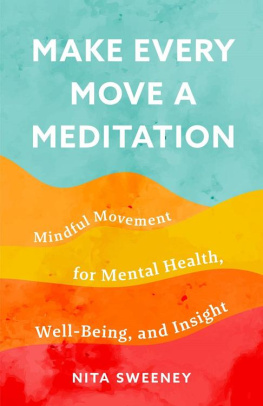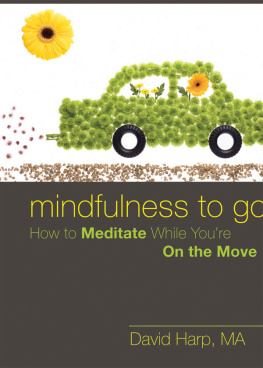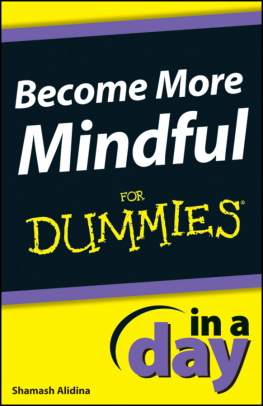The Twelve Bridges

1. Dedication
Meditation is a must, it dont hurt if you try.
Kendrick Lamar
MUSICIANS HAVE TO SET ASIDE time on a regular basis for learning and practice. Even amateur musicians dedicate some time during the week to take lessons and practice. Meditation practice also requires a small but not insignificant degree of dedication.
As opposed to most serious musical practice, meditation does not require a lot of time. Ten minutes a day is a common way to begin a practice. Whereas in music ten minutes wont get you too far, with meditation ten minutes will get you on your way to greater peace and clarity. Yet as with music, the longer your practice sessions, the likelier you are to make progress. So you gradually may want to extend your sitting to fifteen- and twenty-minute sessions to get more benefit.
Even once youve carved out the time to meditate, doing so consistently might present further obstacles. Meditation and mindfulness training are most effective when practiced on a regular basisideally daily. But budgeting the time in your busy schedule to squeeze in this new practice will be a challenge. It will require a level of resolve that can resist the constant demands on your attention. Luckily, thanks to music you already have some skill in this area. When starting out as a budding musician you recognized that you needed to carve out time in your day to practice. Its a reasonable guess that your dedication to learning your instrument helped you find a routine that allowed you to practice more or less consistently. Now you can call on that experience of setting aside distractions on a daily basis to help you progress in this new endeavor. Once youve resolved to make a serious effort to follow the path of mindfulness, applying the dedication and disciplined time management that youve already refined in music to this new practice should be natural.
Dedication is the first bridge because it is not only essential to building a daily practice, but its also pretty much a foundation for everything that follows. No musician ever became moderately successful without being dedicated to making music. A strong resolve is necessary in overcoming the setbacks, failures, disappointments, and disillusionment that we all experience as musicians. Why would meditation practice be any different?
KEY STEPS IN YOUR PRACTICE: CREATING THE CONDITIONS
All of mans misfortunes derive from one thing, which is not knowing how to sit still in a quiet room.
Blaise Pascal
When starting out, creating the conditions for mindful meditation practice will help it take root in our lives. Then the practice happens by itself. Once the soil is prepared, the seed can flower. As Shunryu Suzuki said: Never think that you are sitting zazen... zazen is sitting zazen.
What are some useful conditions for developing mindful meditation? It begins with the intention and commitment to practice. Having trust in the efficacy of practice and taking joy in the pleasures of peace are good foundations in the long term. Having confidence that the more you repeat the process, the more progress you eventually will make, is helpful. Finding joy in the pleasures of peace that meditation can bring is a strong but gentle motivator. And of course, the many links weve pointed to between musical practice and meditative mindfulness practice happily embody conditions that can nurture the practice.
Periodically immersing yourself in the culture of calm attention can tone down the effects of these stress-producing circumstances.
One important way to support your practice is to continue to enrich your understanding of meditation and mindfulness by reading, listening to podcasts, or watching lectures in the field. In daily life you may constantly be faced with stressful situations, failure and disappointment, and looming storms on the horizonnot to mention an endless barrage of information and digital overload designed to tip your tenuous balance. Periodically immersing yourself in the culture of calm attention can tone down the effects of these stress-producing circumstances. And what you learn about mindfulness and meditation from the experience of others not only enhances your understanding of your own experience but also contributes to the conditions that will nurture your practice
TECHNIQUES: BUILDING A REPERTOIRE
Conscious breathing and deep listening are classic techniques in many meditation traditions, from zazen to Tibetan Buddhism, from yoga to vipassana (mindfulness meditation). Ive adapted some of the proven methods and modified them to draw on the experiences, habits, and sensibilities of those who have had some musical training. By amplifying the musical potential within classic methods, we can make meditation and mindfulness training, which can be dry and difficult, more natural and pleasurable. The practitioner can engage with many of these exercises as both a path to heightened awareness and as an improvised performance in the act of composing oneself.
Theres a saying that one who controls the breath controls the mind. Most of the meditation techniques we will go into are based on this classic foundation of focusing on the breath. But there are many other methods that can be included in a full repertoire of techniques and that musically inclined people may be particularly attuned to. These methods easily cross over to general usefulness for anyone with a rudimentary sense of rhythm and tonality.
It may also be helpful to practice different concentration techniques at different times. Just as playing the same scale in the same key ad infinitum may be monotonous and just plain mind-numbing, practicing the same meditation method repetitively may lose effectiveness or appeal. The mind craves novelty and challenge, and its fun to try out new and different meditation strategies depending on the day and the mood.
Sometimes I picture concentration on the breath as the laying down of a solid groove by a rhythm section. While the rhythm section keeps the beat, the lead instruments or voices can go off in infinite directions. Likewise, while attention to the qualities of the breath solidly establishes the focus of our awareness, we can then expand that field of focus to be all-inclusive of whatever is happening in our experience at that moment, and meet it with greater clarity and understanding.
Counting
Since counting to keep time is at the heart of music making, counting the breath can play an important role in some meditative techniques. There are various ways of counting the breath. In most of the classic meditation traditions, the inhalation and exhalation are counted as one breath. Most beginners assume that they should count one on the inhalation and two on the exhalation, and so forth. However, youll find that in the methods discussed here, the inhalation and exhalation are mostly treated as one breath. Some practitioners repeat the number during both the in-breath and out-breath, while others prefer to count only during the exhalation.
Ive heard different reasons for counting the in-breath and out-breath as one. Inhaling and exhaling are two different sides of the same one breath, so why not count it as such? But there are also larger ramifications to the two steps being treated as one. Our perceptions are normally mired in dualistic concepts, tending to perceive two different aspects of a single process as two separate and self-existent events. We discern the differences, which are real, but ignore the fact that these differences are two sides of one unity, as if the coin has a separate and independent front and a separate, independent back. That the in-breath and out-breath are two separate aspects of one unified process and need to be counted as such is representative of a universally nondualistic viewpoint.
Next page






